Solar eclipse of April 8, 2005
A total solar eclipse occurred at the Moon's ascending node on April 8, 2005. A solar eclipse occurs when the Moon passes between Earth and the Sun, thereby totally or partly obscuring the image of the Sun for a viewer on Earth. A total solar eclipse occurs when the Moon's apparent diameter is larger than the Sun's, blocking all direct sunlight, turning day into darkness. Totality occurs in a narrow path across Earth's surface, with the partial solar eclipse visible over a surrounding region thousands of kilometres wide. This eclipse is a hybrid event, a narrow total eclipse, and beginning and ending as an annular eclipse.
| Solar eclipse of April 8, 2005 | |
|---|---|
_(cropped).jpg.webp) Partial from Naiguatá, Venezuela | |
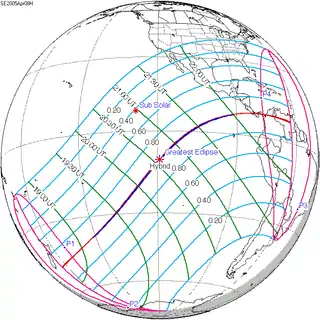 Map | |
| Type of eclipse | |
| Nature | Hybrid |
| Gamma | -0.3473 |
| Magnitude | 1.0074 |
| Maximum eclipse | |
| Duration | 42 sec (0 m 42 s) |
| Coordinates | 10.6°S 119°W |
| Max. width of band | 27 km (17 mi) |
| Times (UTC) | |
| Greatest eclipse | 20:36:51 |
| References | |
| Saros | 129 (51 of 80) |
| Catalog # (SE5000) | 9519 |
It was visible within a narrow corridor in the Pacific Ocean. The path of the eclipse started south of New Zealand and crossed the Pacific Ocean in a diagonal path and ended in the extreme northwestern part of South America. The total solar eclipse was not visible on any land, while the annular solar eclipse was visible in the southern tip of Puntarenas Province of Costa Rica, Panama, Colombia and Venezuela.[1]
Images
.gif)
Animated path
Gallery
.jpg.webp) Christchurch, NZ at sunrise
Christchurch, NZ at sunrise
Related eclipses
Eclipses of 2005
Solar eclipses 2004–2007
This eclipse is a member of a semester series. An eclipse in a semester series of solar eclipses repeats approximately every 177 days and 4 hours (a semester) at alternating nodes of the Moon's orbit.[2]
| Solar eclipse series sets from 2004–2007 | ||||||
|---|---|---|---|---|---|---|
| Ascending node | Descending node | |||||
| Saros | Map | Gamma | Saros | Map | Gamma | |
| 119 | 2004 April 19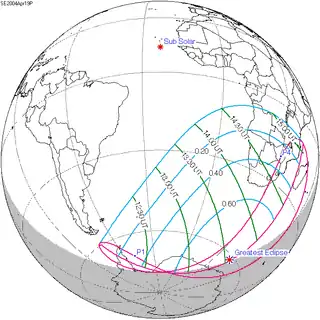 Partial (south) |
-1.13345 | 124 | 2004 October 14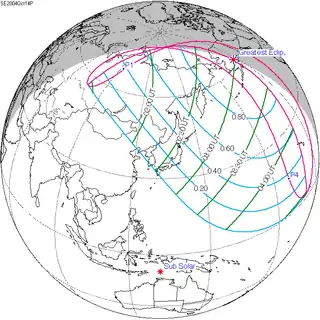 Partial (north) |
1.03481 | |
129_(cropped).jpg.webp) Partial from Naiguatá |
2005 April 8 Hybrid |
-0.34733 | 134 Annular from Madrid, Spain |
2005 October 3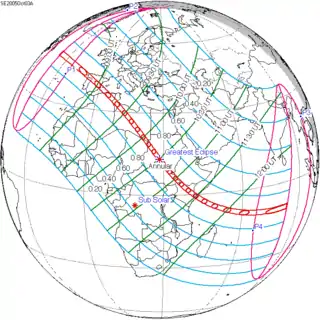 Annular |
0.33058 | |
139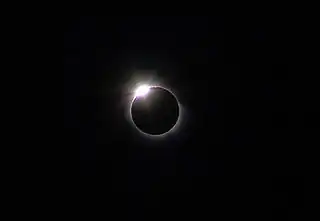 Total from Side, Turkey |
2006 March 29 Total |
0.38433 | 144.jpg.webp) Partial from São Paulo, Brazil |
2006 September 22 Annular |
-0.40624 | |
149_(cropped).jpg.webp) From Jaipur, India |
2007 March 19 Partial (north) |
1.07277 | 154_(cropped).jpg.webp) From Córdoba, Argentina |
2007 September 11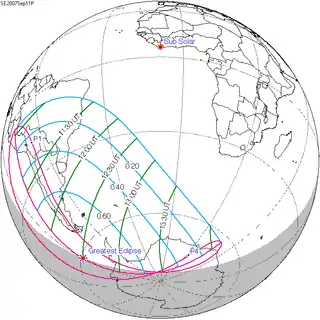 Partial (south) |
-1.12552 | |
Saros 129
It is a part of Saros cycle 129, repeating every 18 years, 11 days, containing 80 events. The series started with partial solar eclipse on October 3, 1103. It contains annular eclipses on May 6, 1464 through March 18, 1969, hybrid eclipses from March 29, 1987 through April 20, 2023 and total eclipses from April 30, 2041 through July 26, 2185. The series ends at member 80 as a partial eclipse on February 21, 2528. The longest duration of totality was 3 minutes, 43 seconds on June 25, 2131 . All eclipses in this series occurs at the Moon’s ascending node.[3]
| Series members 46–56 occur between 1901 and 2100: | ||
|---|---|---|
| 46 | 47 | 48 |
 February 14, 1915 |
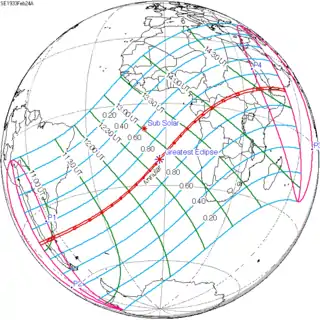 February 24, 1933 |
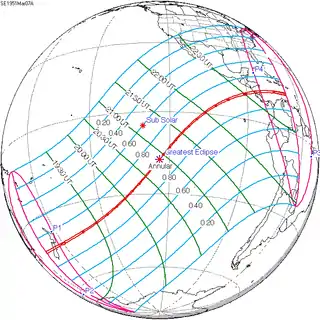 March 7, 1951 |
| 49 | 50 | 51 |
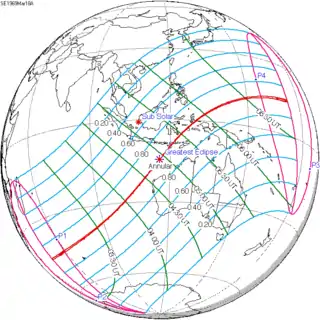 March 18, 1969 |
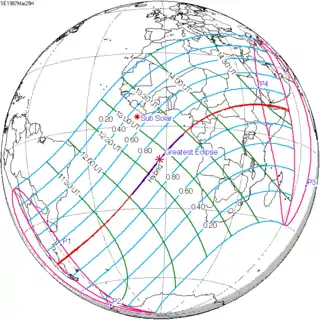 March 29, 1987 |
 April 8, 2005 |
| 52 | 53 | 54 |
 April 20, 2023 |
 April 30, 2041 |
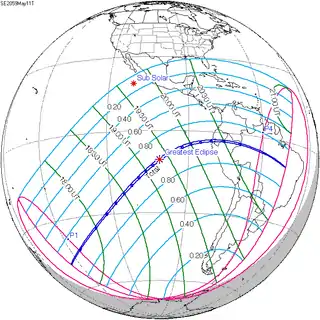 May 11, 2059 |
| 55 | 56 | |
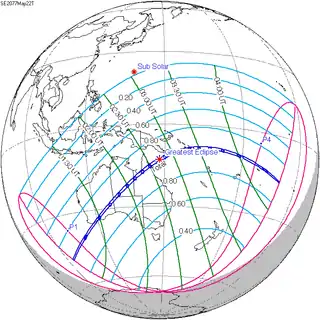 May 22, 2077 |
 June 2, 2095 | |
Metonic series
The metonic series repeats eclipses every 19 years (6939.69 days), lasting about 5 cycles. Eclipses occur in nearly the same calendar date. In addition, the octon subseries repeats 1/5 of that or every 3.8 years (1387.94 days). All eclipses in this table occur at the Moon's ascending node.
| 21 eclipse events between June 21, 1982, and June 21, 2058 | ||||
|---|---|---|---|---|
| June 21 | April 8–9 | January 26 | November 13–14 | September 1–2 |
| 107 | 109 | 111 | 113 | 115 |
| June 21, 1963 | April 9, 1967 | January 26, 1971 | November 14, 1974 | September 2, 1978 |
| 117 | 119 | 121 | 123 | 125 |
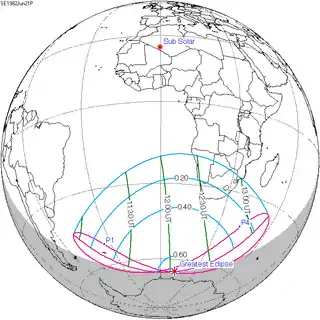 June 21, 1982 |
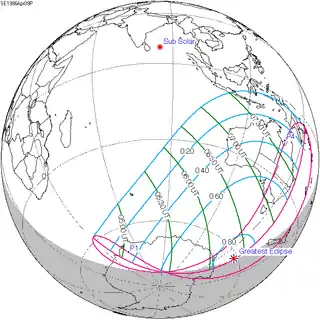 April 9, 1986 |
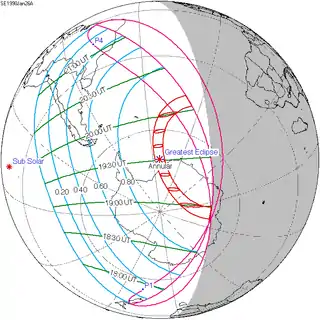 January 26, 1990 |
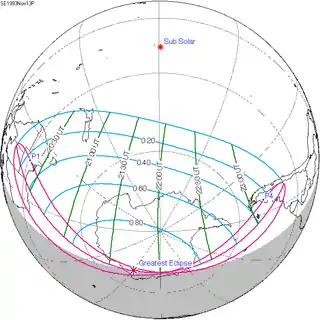 November 13, 1993 |
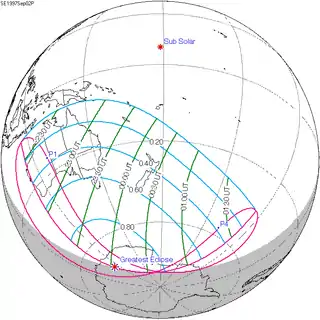 September 2, 1997 |
| 127 | 129 | 131 | 133 | 135 |
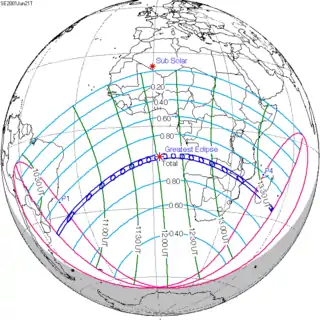 June 21, 2001 |
 April 8, 2005 |
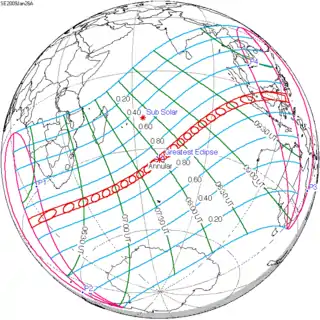 January 26, 2009 |
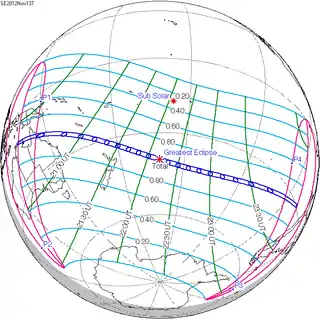 November 13, 2012 |
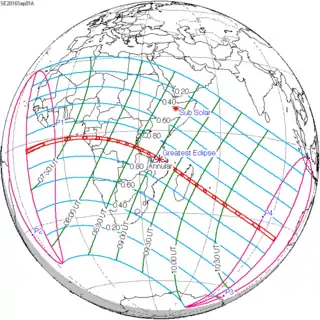 September 1, 2016 |
| 137 | 139 | 141 | 143 | 145 |
 June 21, 2020 |
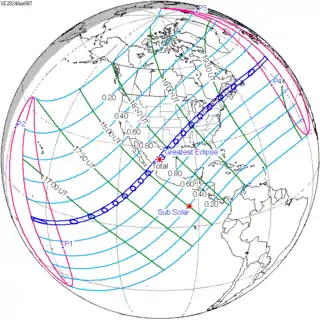 April 8, 2024 |
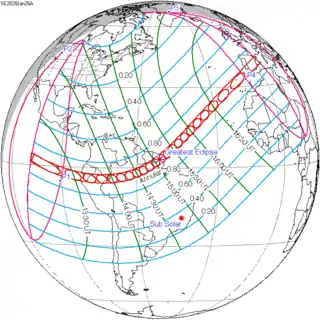 January 26, 2028 |
 November 14, 2031 |
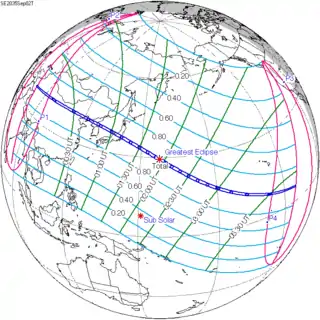 September 2, 2035 |
| 147 | 149 | 151 | 153 | 155 |
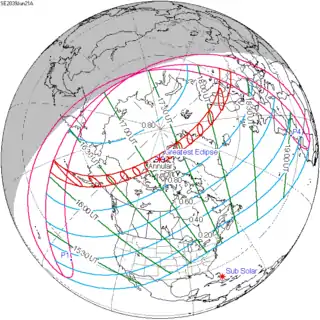 June 21, 2039 |
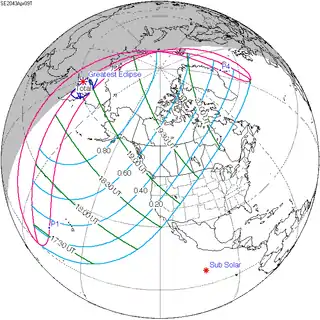 April 9, 2043 |
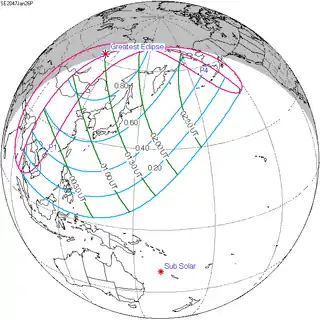 January 26, 2047 |
 November 14, 2050 |
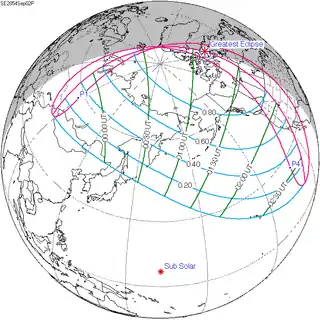 September 2, 2054 |
| 157 | ||||
 June 21, 2058 | ||||
Notes
- Espenak, Fred. "Hybrid Solar Eclipse of 2005 Apr 08 - Google Maps and Solar Eclipse Paths". NASA Eclipse Web Site.
- van Gent, R.H. "Solar- and Lunar-Eclipse Predictions from Antiquity to the Present". A Catalogue of Eclipse Cycles. Utrecht University. Retrieved 6 October 2018.
- Espenak, F. "NASA Catalog of Solar Eclipses of Saros 129". eclipse.gsfc.nasa.gov.
References
- Earth visibility chart and eclipse statistics Eclipse Predictions by Fred Espenak, NASA/GSFC
- Google Map
Photos:
- Prof. Druckmüller's eclipse photography site. South Pacific (MV Discovery)
- Prof. Druckmüller's eclipse photography site. Pacific (MV Galapagos Legend)
- Spaceweather.com eclipse gallery
- Clouds, Plane, Sun, Eclipse, North Carolina, USA APOD 4/11/2005
- Hybrid Solar Eclipse, combined photo of totality 2,200 kilometers west of the Galapagos and annularity at Penonome Airfield APOD 5/6/2005
- A Rare Hybrid Solar Eclipse, APOD 11/3/2013
| Wikimedia Commons has media related to Solar eclipse of 2005 April 8. |
.jpg.webp)

